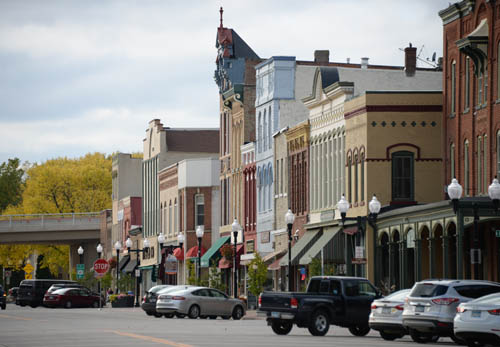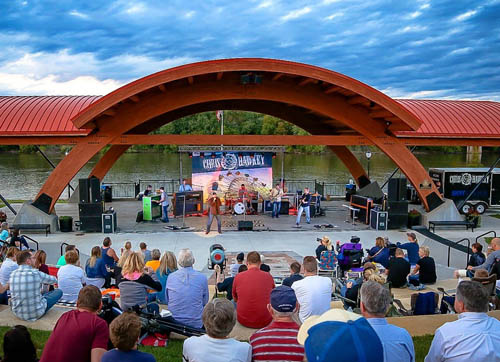Hastings may be a historic city, but city officials are drawing on 21st century techniques to engage community members in planning for its future. One is a computerized mapping tool that residents can use to comment on city locations that may warrant attention in the city’s new 2040 comprehensive plan.
City officials expect their efforts to yield ideas from around the community about how to maintain its historic character and capitalize on its natural beauty while it grows in population and economic strength.
Rivers play key role in Hastings’ story
 In Minnesota’s history, geography favored the city of Hastings with a location near the confluence of three rivers—the Mississippi, Vermillion, and St. Croix.
In Minnesota’s history, geography favored the city of Hastings with a location near the confluence of three rivers—the Mississippi, Vermillion, and St. Croix.
For hundreds of years before European settlement, the Dakota and other indigenous people lived, hunted and fished in the area, traveling on the rivers.
Then in the early 1800s, steamboats discovered Hastings’ deep-water harbor, and the waterfall on the Vermillion River provided power for milling grain.
Incorporated as a city in 1857, nearly all of Hastings is in Dakota County but a small portion extends into Washington County. The city derives its named from the state’s first elected governor, Henry Hastings Sibley, and it serves as the seat of Dakota County government.
HASTINGS COMMUNITY PROFILE
Location – Eastern Dakota County
Population – 22,400*
Households – 8,955*
Jobs – 8,375*
Top employers – Dakota County government, Regina Hospital, School Dist. 200, Smead Manufacturing Co., Intek Plastics.
Notable features – Well-preserved Victorian buildings in downtown and other sites; 35-foot Vermillion Falls; 215-acre Hastings River Flats Park; boating, marinas and Lock & Dam 2 on Miss. R.
Regional Parks –Spring Lake Regional Park, located a few miles northwest of city on Miss. R.
Major highways – East/west: Minn. Hwy. 55; North/south: U.S. Hwy. 61
Regional Transit – Transit Link
*Metropolitan Council 2016 estimates
Located in metro area’s southeast
“Hastings is about a 25-minute drive from downtown Saint Paul, shorter than some job commutes,” said Morgan Hill, Hastings economic development coordinator. “So we’re not as far away from the heart of the metro area as some may think.”
She said the city has a lot to offer by way of its historic character, nature-based recreation, and business opportunities.
Well-preserved historical buildings
The community knows and cares for its history. Hastings is nationally recognized for its well-preserved Victorian architecture – in its historic downtown and at other local sites.
The city can boast 63 buildings built between 1859 and 1959 on the National Historic Register. Among them are 33 commercial buildings, 28 private homes, and 2 churches. Additional commercial and other sites are locally designated historic properties.
An attraction for both residents and tourists is 50 or so historic buildings in Hastings’ downtown along East Second Street. Owners have adapted their buildings to meet the needs of 21st century retailers, while maintaining the unique feel only a historic building can offer.
Protected natural features and parks
 Close-in natural features complement Hastings’ historical character. Just a few blocks east of downtown is Lake Isabel, a popular fishing spot in the community.
Close-in natural features complement Hastings’ historical character. Just a few blocks east of downtown is Lake Isabel, a popular fishing spot in the community.
A newly completed 10-mile bike and walking trail loops around the city, highlighting top tourism draws, such as the Hastings RiverWalk, the Rotary Pavilion performance venue, and the 35-foot Vermillion Falls.
“On top of that, the city is linked up with Dakota County’s Mississippi River Trail that winds through Spring Lake Regional Park upstream,” said John Hinzman, Community Development Director. “We expect the trail will soon connect all the way to Saint Paul,” he said.
“In addition, finishing touches are currently being made to a trail that connects with Prescott, Wisconsin, across the St. Croix River, and we’re working on yet another that will extend to Red Wing. We hope to become a major trail center here,” Hinzman said.
 In the northwestern part of the city, below the Mississippi River bluffs, lies the 215-acre Hastings River Flats Park – a large natural area that’s part of the Hastings park system. To the southeast, the Hastings Scientific and Natural Area (SNA) hosts old-growth red oak, sugar maple, and basswood. Even the inhospitable rocky slopes and limestone walls are habitat for hardy moss and lichens.
In the northwestern part of the city, below the Mississippi River bluffs, lies the 215-acre Hastings River Flats Park – a large natural area that’s part of the Hastings park system. To the southeast, the Hastings Scientific and Natural Area (SNA) hosts old-growth red oak, sugar maple, and basswood. Even the inhospitable rocky slopes and limestone walls are habitat for hardy moss and lichens.
Toward the southeastern part of the city lies the Hastings Sand Coulee Scientific and Natural Area (SNA). Its 267 acres encompasses a diverse and rare dry sand-and-gravel prairie, the remnant of an ancient glacial stream. In fact, five state SNAs and four Audubon-sanctioned Important Bird Areas (IBAs) located in and around Hastings have helped the city to become the first official Bird City Minnesota.
Planning to the year 2040
In the mid-1960s, the community began its own comprehensive planning effort and adopted its first plan in 1971, a year before the Legislature approved the planning requirement for all communities in the metro area.
Hastings is currently laying the groundwork for its 2040 long-range comprehensive plan. “We’re hearing that residents want to maintain our historic river-town character, while we continue to grow,” said Justin Fortney, City Planner.
“Our discussions point toward increasing our focus on economic competitiveness, including boosting workforce skills and recruitment, strengthening our downtown, and attracting business to our fully serviced industrial park,” Hill said. “We hope to increase residential development in the city and create a better functioning and more attractive corridor along Vermillion Street.”
 A city steering committee is guiding a wide range of activities to draw out the thoughts, ideas and attitudes of residents, including young people, business owners and others, and to spread the word about the city’s planning process. The committee will use feedback from the community to reshape the directions set in the city’s 2030 plan to better reflect the community’s current vision for the future.
A city steering committee is guiding a wide range of activities to draw out the thoughts, ideas and attitudes of residents, including young people, business owners and others, and to spread the word about the city’s planning process. The committee will use feedback from the community to reshape the directions set in the city’s 2030 plan to better reflect the community’s current vision for the future.
The city has undertaken an extensive outreach effort. “We’ve created a website devoted to the planning project, with posts about updates and other news,” Fortney said. “We are pushing out a survey to all corners of the community so we have a complete picture of where people want the city to go.” The city also held interviews and focus group sessions with key stakeholders.
“We’re using a mapping tool that enables community members to offer their thoughts about individual locations around the city via their computer, laptop or smart phone,” Fortney said. “We’re even working with local students to respond in an open-ended survey. We’d like to find out how they feel about their community and know what their hopes are.”
The city mailed a newsletter to all residents explaining the comprehensive planning process and encouraging them to take advantage of the feedback channels the city provides. A city representative explained the planning process in interviews on local radio station KDWA.
Facebook and Twitter were drawn into the effort to prompt social-media users to get involved, and email users can subscribe to notifications for updates.
Officials distributed flyers at locations and activity sites wherever the opportunity arose. “We’re making use of community events to convey and exchange information – for example, at our Rivertown Days last summer and our Holiday Hoopla in November,” Fortney said.
Hastings is showing how a community can honor its unique historic aspects while welcoming in new and expanding economic development initiatives, recreational amenities for residents and visitors of all ages, and using multiple outreach efforts to engage all residents of the community as it envisions its future.
See how the Metropolitan Council supports communities across the region in their planning processes.